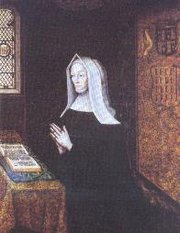Margaret Beaufort
|
|
Margaret Beaufort (May 31 1443–June 29 1509) was the daughter of John Beaufort, 1st Duke of Somerset, granddaughter of John Beaufort, 1st Earl of Somerset and great-granddaughter of John of Gaunt and his mistress Katherine Swynford; following Gaunt's marriage to Katherine, their children (the Beauforts) were legitimized, but their descendants were barred from ever inheriting the throne, though every monarch since Edward IV of England is their descendant.
Edward and his younger brother Richard III of England were sons of Cecily Neville, grandsons to Joan Beaufort, great-grandsons to John of Gaunt and Katherine Swynford.
Margaret married four times, but had only one child. That child became Henry VII of England.
Margaret's first marriage, to John de la Pole, took place in 1450, when she was still a child, but was annulled after a short time. Her second cousin Henry VI had as yet no children, and considered naming her his heir. He married her to his half-brother, Edmund Tudor, Earl of Richmond. Edmund was the eldest son of the king's mother, dowager Queen Catherine (the widow of Henry V) by her illegal (and so legally invalid) second marriage to a Welsh squire in her household, Owen Tudor. Thus, in one of the great ironies of history, Margaret's son Henry, the Lancastrian claimant to the throne at the end of the Wars of the Roses -- the one who won it all and united the two houses by marrying the Yorkist princess Elizabeth of York -- had plenty of royal blood but no legal claim to the throne.
Edmund died while she was only thirteen and pregnant with their son. The difficult birth left her unable to have any more children. Nevertheless, Lady Margaret soon married her third husband, Sir Henry Stafford, son of the 1st Duke of Buckingham. Following his death in 1471, she took a vow of chastity, but this did not prevent her from marrying Thomas, Lord Stanley, some time between 1473 and 1482. Stanley, who had switched sides repeatedly during the Wars of the Roses, chose to double-cross King Richard on the battlefield at the Battle of Bosworth Field in 1485 and so throw the victory to Margaret's son Henry Tudor. Stanley was later made Earl of Derby, which made Margaret Countess of Derby, and she was still the dowager Countess of Richmond. She was known for her education and her piety, and her son is said to have been devoted to her.
In 1502 she established the Lady Margaret's Professorship of Divinity at the University of Cambridge.
Her portrait, at prayer in her richly furnished private closet behind her chamber, is a rare contemporary glimpse into a late Gothic aristocratic English interior. It rewards a close look. The severe black of her widow's weeds contrasts with the splendor of her private apartment, where every surface is patterned, even the floor alternating cream-colored and terracotta tiles. The plain desk at which she kneels is draped with a richly patterned textile that is so densely encrusted with embroidery that its corners stand away stiffly. Her lavishly illuminated Book of Hours is open on a richly worked pillow before her. The walls are patterned with oak leaf designs, perhaps in lozenges, perhaps of stamped and part gilded leather. Against it hangs the dosser of her canopy of estate, with the tester above her head (the Tudor rose at its center) supported on cords from the ceiling. The coats-of-arms woven into the tapestry are of England (parted as usual with France) and the portcullis badge of the Beauforts, which the early Tudor kings would use. Small stained glass roundels in the leaded glass of her lancet windows also carry both England (cropped away here) and Beaufort.
External links
- A short profile of Margaret alongside other influential women of her time (http://www.guide2womenleaders.com/womeninpower/Womeninpower1450.htm)
- E.M.G. Routh, Lady Margaret: A Memoir of Lady Margaret Beaufort, Countess of Richmond & Derby, Mother of Henry VII, 1924: (http://tudorhistory.org/secondary/beaufort/contents.html) e-text

